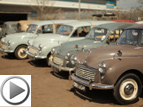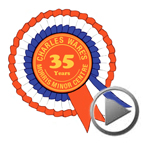A Series III Minor
By Paul Skilliter, Practical Classics 1985
Thirty seven years ago there were few closed cars that could out handle a Morris minor, and even though it wasn't terribly fast in a straight line, owners of sporty saloons of 3-litres and more found it surprisingly difficult to put up better average speeds over mixed roads. Such was the engineering competence of the Morris Minor back in 1948, fresh off the drawing board of Alec Issigonis.
In 1952 the 'A' series engine borrowed from the Austin A30 brought overhead valves to the Minor in its Series II form, the famous '1000' with an extra 143cc arrived in 1956, while from 1962 onwards the Minor was powered by the lusty 1098cc version of the 'A' series unit. Then, a 0-50mph time of 15.5 seconds and a top speed of 74mph were perfectly acceptable - but in 1985, 23 years later, that equates with slow.
Likewise the Minors legendary road holding, already dated by the 60's, is far below modern standards and in particular, the skittish rear end can catch the unwary out. So what you might say, it's an old car and we can forgive it a few things like that. But consider for a moment - wouldn't it be nice to have a minor which, while it looked just as it always has, possessed that little bit of extra urge to get you past lorries on a steep hill, brakes that were so good you could forget about them, and cornering abilities that took away all fears of sharp bends met unexpectedly in the dark.
Well Charlie Ware of the Morris Minor Centre, Bath, certainly thinks that there are plenty of Minor owners around who would appreciate benefits like these - people who have run a Morris for perhaps twenty tears, don't want a modern tin box, but would like more in keeping with 1985 traffic conditions.
Thus was born the idea of a 'Series III' Morris Minor - but not a hotrod for the boy racer type, rather a carefully engineered development of the minor aimed at the family motorist. However as I discovered when I drove the prototype car, there's lots to interest the sports saloon enthusiast too!
The car has been approached from four main directions: suspension, brakes, drive train and interior. Each of these will be offered as individual ' packages', or they can all be installed at the same time. Modifying a Minor is far from new, but where this project differs from previous efforts is that the subject has been tackled from basics and with the future very much in mind. Thus essential to the project is the use of Ital (marina) parts, especially adapted for the Minor, instead of just modifying the car's existing components.
The Marina (codenamed ADO28 and launched in 1971) did, of course employ Minor front suspension, fitted with larger hub bearings and eventually, big 9.75" disc brakes, though retaining the top arm and bulkhead mounted damper. What the new 'Series III' Minor uses is that larger hub and the disc brakes, in conjunction with telescopic dampers which replace the relatively weak and short-lived original lever arm type.
Then, at the rear, the Minor axle has been discarded and in its place is an Ital unit, which has stronger half shafts, a slightly wider track, a bigger choice of useful final drive ratios and larger 8" drum brakes. Again telescopic dampers replace the lever arm type, and entirely new four-leaf springs are fitted; a most important further modification is the installation of radius arms - these together with the vertically mounted dampers, are aimed at countering one of the Minor's failings, axle tramp caused by the road springs 'winding up'.
Marina wheels are used too and they suit the car well. They are wider than the minors and an inch smaller in diameter, which lowers the car's centre of gravity and allows a greater choice of tyres. At present the development car is shod with Goodyear Grand Prix 'S' radial tyres, 155 section and a standard profile.
Inside the car the new seats are obvious. They have been commissioned by the Centre from Callow & Maddox, and are at based on Metro seat frames. At present the remainder of the interior is standard, but various changes (like modern 'stick' controls, fresh-air ventilation etc) are in the pipeline for introduction later.
Of course the engine has a vital part to play in the scheme of things. On the prototype Traveller, modifications are based on the 1098cc engine; the original 12G 202 head is replaced by the later (1300) type 12G 295 which doesn't suffer from the inlet valves being masked by the combustion chamber wall, while the valves themselves are larger.
The combustion chambers and porting are cleaned up and the original cast iron inlet and exhaust manifold thrown away and replaced by a long centre branch tubular exhaust manifold and a new inlet manifold carrying a 1.5" instead of 1.25" SU carburettor. The standard exhaust pipe and silencer create considerable backpressure and so a new exhaust system with a straight through silencer is installed. A different camshaft is fitted (though this like many aspects of the prototype is still being experimented with) and the resultant power increase given by the developed engine is around 75% - 64bhp as opposed to 34bhp.
As for who has carried out this development work, the Morris Minor Centre sub-contracted it out, Charles Ware reasoning that while they could have a shot at it themselves it was best left to experts in the field; it would also allow the Centre's own workshop to continue earning money - and you need quite an investment for such an all embracing update of an old car. So A.D. Engineering have been retained, largely through a chance meeting when Geoff Moore of A.D happened to come in to the Centre with a relative during a routine examination of a minor. Geoff has a lengthy background of rally preparation work while his right hand man, project engineer Jerry Felstead, shares a similar in making cars better and faster. They in turn have received assistance from Oselli Engineering with the power unit, though the chassis development is their work alone.
When I arrived at A.D. Engineering's new and spotless unit in Wells I was not at all sure what to expect of the 'SeriesIII' Minor. I'd read the specification and indeed had talked over the idea with Charlie Ware almost since its inception, but what would the resulting car be like? Could the Minor be updated without turning it into some raucous, boy-racer machine?
By arrangement the Centre provided a standard Traveller to enable a direct comparison to be made and off we went in convoy into the Mendips - accompanied by Hugh Sykes, who was there to investigate the story on behalf of Radio 4's 'Today' programme (Hugh in fact drives a two-door Minor everywhere so was well qualified to do so).
I drove the standard Minor first - and a very nice old car it was too. Selected because it had brakes, steering, suspension and engine all in excellent order, I could only marvel at how good an ordinary Minor can be if it's in perfect condition, with the lightness of it's controls and very flexible if not powerful engine making it very pleasant to drive. However all the old faults were there too - the rather bouncy ride, the very upright seats, the tendency of the rear end to hop and tramp, the high brake pedal pressures and acceleration which if acceptable around town, is barely adequate for main road overtaking.
Swapping over to the 'SeriesIII' Traveller I immediately felt more comfortable in the wide, cloth upholstered seats and there was a nice leather-covered steering wheel to hold as well, smaller in diameter than the original. The clutch engaged smoothly and we were off; first impressions were a) considerable inlet roar and b) a ride which appeared only marginally superior to the original car's. The modified engine was flexible but didn't appear to have a better pick-up from (say) 25mph in top. It revved very freely though, and while no rev counter was fitted (just change-up points marked on the Speedo) Geoff says there is no tail off of power at 6,000rpm - the original engine fades at 5,500rpm. Third gear on the 'new' car gives a little over 60mph, and acceleration once the revs were used was impressive.
It wasn't until Geoff found a stretch of road often included as a 'special selective' stage by rally organisers that I appreciated the true worth of the car however. Extending the car over this undulating route revealed that it was in a totally different class to the standard Minor - there was an almost complete absence of roll or tyre squeal, and it felt immensely stable and safe both when put into a corner at ridiculously high speeds for a Minor and when driven at 70mph over sharp brows and corrugations. It remained completely controllable in such conditions and was not the slightest bit disturbed by anything I could throw at it. In short, its handling was way beyond the imagination of a 'standard-Minor' owner and personally I'd rate it ahead of a modern hatchback like a Fiesta or Astra. All the more creditable in view of the relatively modest tyre section employed - 155. A wider tyre can't be fitted at present because the rear damper mounting in the wheel arch doesn't allow the space - but a new wing is planned to counter this.
Traversing a very rough farm track again showed impeccable damping and while the car was noisy the bump stops weren't brought into play. On more normal surfaces the ride was good thanks to the softer rear springs, although I felt that slightly softer damping would usefully improve this aspect of the car without losing too much in the way of road holding. The steering wasn't quite as light as on a standard car (due to the smaller diameter steering wheel and wider tyres) but was still excellent.
Then the brakes, these were simply a revelation. OK so a Minor does stop if you press hard enough for long enough, but fitted with the big marina discs and drums the Series III car is again on a different plane, with an unrecognisable stopping ability compared to the standard car.
As you will have detected I am pretty enthusiastic about the Series III Minor and I think this came across during the 'Today broadcast a couple of weeks later. What faults there are have already been noted by A.D, with softer damping and a NVH (noise, vibration & harshness) campaign about to be embarked upon - that noisy intake, for example was due to an experimental air filter installed purely to evaluate the breathing of the engine without regard to silencing. The ride is due for further improvement when a thinner torsion bar can be produced, though as I said, slightly softer damping would probably do the trick - the car is I feel set up for the sporting motorist rather than the average driver at the moment.
It is envisaged that these improvements will be offered either as a complete package or in most cases individually. However some of the items are linked - for example, the brake conversion really involves fitting the servo, Ital rear axle and front discs all at once, which means you also get the radius arms and rear telescopic dampers.
There will be plenty of choices in the engine department though, and while the uprated 1098cc unit is quite satisfactory, it does seem more appropriate to base a conversion on the larger 1275cc engine - effectively the Marina/Ital 1300cc engine which together with the Triumph all synchromesh gearbox is working at its upper limits with a tuned engine and the Centre feels it is more sensible to use the tougher Triumph unit in the future. The chassis would certainly cope with the 1300's extra horsepower though Geoff is considering using a panhard rod on the rear axle to locate it even more firmly.
The use of the larger engine suitably modified brings visions of a sort of Golf Gti cabriolet Minor - fashion; such a vehicle with all the chassis mods would certainly be entertaining! But Charlie Ware is still basically aiming at those who still want to use a Minor seriously in everyday conditions, rather than purely for fun, and the Series III merely represents another step along the road of ensuring that the Minor remains with us in a still useful guise well into the next century. That includes remanufactured bodyshells, which, for the Traveller at least is not far off being a reality.
As for the cost of modifying your Minor it is true that for the whole shooting match - engine, suspension, brakes and interior - it would extend into two or three thousand pounds. But you would need to bear in mind that the whole specification has been tailored and engineered into the Minor and is not a collection of random performance bits of dubious efficiency simply bolted onto the car. The cost is minimised too by the fact that the new parts will often replace worn items that in any case would have to be renewed and so far as the enthusiast is concerned, the intention is to market adapted parts which will enable the D.I.Yer to locate his own Marina/Ital units in the scrapyard and fit them himself to his Minor. Soon, if not now, Marina axles, brakes, engines and gearboxes will be cheaper and more readily obtainable than Morris Minor equivalents.
Yes, I think the Series III Minor is a success, though as always, it will be the market place itself that will be the final arbitrator of whether it will be a saleable proposition. It deserves to be however and I for one would certainly like a 100mph+ Minor Convertible with handling and brakes to match. A car with more fun potential is hard to imagine.
PAUL SKILLETER
(This article was originally published in Practical Classics Magazine, 1985)










